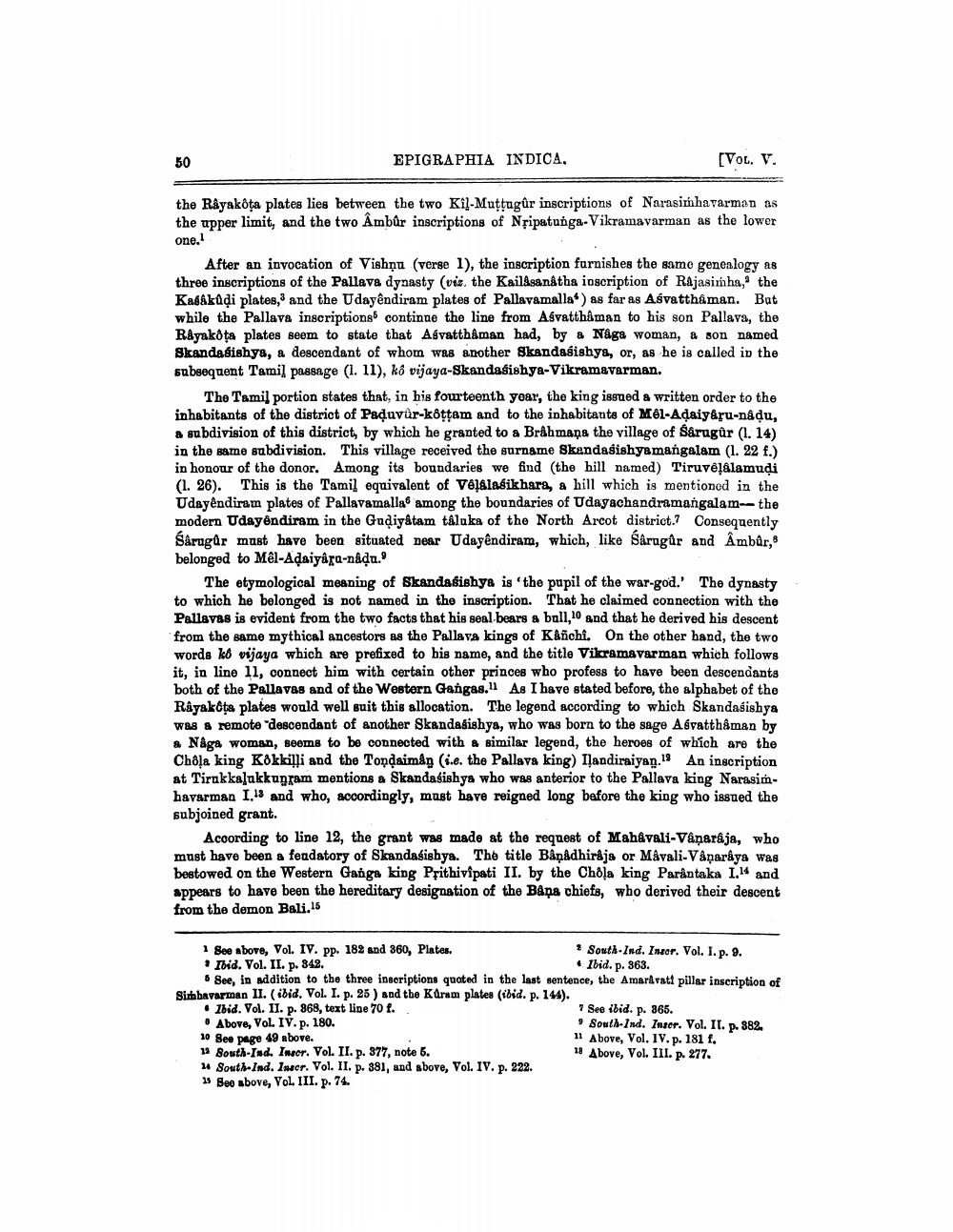________________
EPIGRAPHIA INDICA,
[Vol. V.
the Râyaköţa plates lies between the two Kil-Muttagûr inscriptions of Narasimhavarman as the upper limit, and the two Ambur inscriptions of Nřipatunga-Vikramavarman as the lower one.
After an invocation of Vishnu (verse 1), the inscription furnishes the same genealogy as three inscriptions of the Pallava dynasty (viz. the Kailasanatha inscription of Rajasimha, the Kabakadi plates, and the Udayêndiram plates of Pallavamalla) as far as Agvatthaman. But while the Pallava inscriptions continue the line from Asvatthåman to his son Pallava, the Råyakota plates seem to state that Asvatthaman had, by a Någa woman, a son named Skandesishya, a descendant of whom was another Skandasishya, or, as he is called in the subsequent Tamil passage (1. 11), ko vijaya-Skandasishya-Vikramavarman.
The Tamil portion states that, in his fourteenth year, the king issued a written order to the inhabitants of the district of Paduvür-kottam and to the inhabitants of Mél-Adaiy&ru-nadu, & subdivision of this district, by which he granted to a Brahmana the village of Sarugûr (1. 14) in the same subdivision. This village received the surname Skendasishyamangalam (1. 22 f.) in honour of the donor. Among its boundaries we find (the hill named) Tiruvélalamudi (1. 26). This is the Tamil equivalent of Vélalaśikhara, a hill which is mentioned in the Udayêndiram plates of Pallavamalla among the boundaries of Udayachandramangalam-- the modern Udayêndiram in the Gudiyâtam tåluka of the North Arcot district. Consequently Śårugur must have been situated near Udayêndiram, which, like Saragür and Âmbar, belonged to Mêl-Adaiyara-nadu.
The etymological meaning of Skandasishya is 'the pupil of the war-god.' The dynasty to which he belonged is not named in the inscription. That he claimed connection with the Pallavas is evident from the two facts that his seal bears a ball, and that he derived his descent from the same mythical ancestors as the Pallava kings of Kanchi. On the other hand, the two words ko vijaya which are prefixed to his name, and the title Vikramavarman which follows it, in line 11, connect him with certain other princes who profess to have been descendants both of the Pallaves and of the Western Gangas.ll As I have stated before, the alphabet of the Rayakta plates would well suit this allocation. The legend according to which Skandasishya was a remote descendant of another Skandasishya, who was born to the sage Agvatthåman by
Någa woman, seems to be connected with a similar legend, the heroes of which are the Chôļa king Kokkili and the Tondaimag (i.e. the Pallava king) Iļandiraiyan.18 An inscription at Tirukkalukkugram mentions a Skandasishya who was anterior to the Pallava king Narasimhavarman 1.13 and who, accordingly, must have reigned long before the king who issued the subjoined grant.
Acoording to line 12, the grant was made at the request of Mahávali-Vanaråja, who must have been a fendatory of Skandasishya. The title Bånadhiraja or M&vali-Vanaraya was bestowed on the Western Ganga king Prithivîpati II. by the Chola king Parântaka 1.14 and appears to have been the hereditary designation of the Bana chiefs, who derived their descent from the demon Bali,15
1 See above, Vol. IV. pp. 182 and 860, Plates.
* South-Ind. Insor. Vol. I. p. 9. . Ibid. Vol. II. p. 342.
• Ibid. p. 363. See, in addition to the three inscriptions quoted in the last sentence, the Amaravati pillar inscription of Sidabavarman II. (ibid. Vol. I. p. 25 ) and the Kdram plates (ibid. p. 144). • Ibid. Vol. II. p. 868, text line 70 f..
7 See ibid. p. 365. . Above, Vol. IV. p. 180.
South-Ind. Insor. Vol. II. p. 382. 10 See page 49 above.
11 Above, Vol. IV. p. 181 f. 11 South-Ind. Inscr. Vol. II. p. 377, note 6.
18 Above, Vol. III. p. 277. 4 South-Ind. Inscr. Vol. II. p. 381, and above, Vol. IV. p. 222. 15 Seo above, Vol. III. p. 74.




